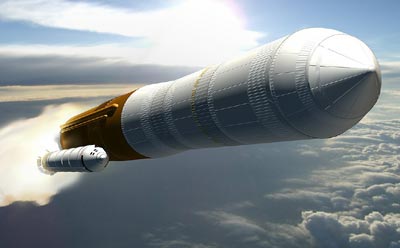Will technology accelerate Ares development?by Anthony Young
|
| Cynics in program management today often refer to “death by PowerPoint” when describing their frustration in trying to move programs forward without dealing with a gauntlet of incessant presentation meetings. |
Drawings for practically every piece of equipment used for Apollo were produced using mechanical lead pencils on velum paper or ink on Mylar, drawn on drafting tables. Copies were made from the familiar blueprint process. Copies of letters and memos were usually carbon copies. Facsimile machines did exist, but they were slow and resolution far from ideal.
For all of America’s and the world’s advances in technology in all its forms today, some argue it has not accelerated this nation’s ability to design, build, and launch hardware into space. As a design engineer who has used CAD software for the last 20 years, I would have to agree, in part, with that skeptical view. Cynics in program management today often refer to “death by PowerPoint” when describing their frustration in trying to move programs forward without dealing with a gauntlet of incessant presentation meetings.
George Low didn’t need PowerPoint
Peter Norvig created a buzz back in 1999 when he produced and eventually placed on the web “The Gettysburg PowerPoint Presentation”. He did it to prove a point. Lincoln’s great and concise speech fell apart when presented in a graphical medium employed simply because that medium existed. In its original form, the speech was superb and has stood the test of time. Presented in PowerPoint—because so many presentations are done this way today—much of the speech’s power, as well as emotion, were lost. In one of his subsequent articles, “PowerPoint: shot with its own bullets”, Norvig cited a superb example of clearheaded decision-making achieved during Project Apollo without the aid of technology:
For an example of excellent decision-making without PowerPoint, consider the agenda of Apollo program-manager George Low, on Aug 9, 1968. At 0845, Low met with Houston center-director Robert Gilruth to recommend that the Apollo 8 mission attempt a lunar orbit, an ambitious change from previous plans. Gilruth agreed. At 0900, Low met with flight-director Chris Kraft, who verified the technical feasibility. At 0930 Low, Gilruth and Kraft agreed to present the idea to Wernher von Braun. They flew to Huntsville to meet von Braun and others at 1430 that afternoon. The lunar orbit plan was tentatively approved that day. Just 4 months later, Apollo 8 orbited the Moon, sending back the first photograph of an Earthrise over another world.
Think what Low accomplished in the time that many present-day bureaucrats take to select their fonts and backgrounds. He achieved consensus on a billion-dollar decision about one of the most complex engineering projects of all time, with enormous implications for national security. PowerPoint cannot help you do that.
There are sophisticated software programs today that can not only aid in the design of complex parts and assemblies, but also perform stress analysis and perform thermodynamic, mechanical, and electrical failure analysis so costly destructive testing does not have to be performed. Such software should drastically compress the time it takes to conduct research, design, development, test, and validation of much flight hardware.
With the vast resources of technology available today, how long do you think it would take to conduct an identical Apollo program if there was comparable funding? Do you think it could be achieved in less time than it took nearly forty years ago? It is axiomatic that the shorter a space vehicle development program is, the less expensive it will be at the end. Why can’t such technology be employed to effectively shorten the design and development programs within Project Constellation?
| It is axiomatic that the shorter a space vehicle development program is, the less expensive it will be at the end. Why can’t such technology be employed to effectively shorten the design and development programs within Project Constellation? |
There is, of course, the issue of money and manpower. Constellation is operating at nowhere near the pace and funding of Apollo. NASA must also continue to operate the shuttle program and manage the International Space Station. Nevertheless, design and development of Ares 1 and Ares 5 should consume less time than Saturn 1 and Saturn 5 by harnessing the technological tools available today and taking into account the solid rocket motor design common to both launch vehicles has already been designed and proven.
One thing is certain. This current and future technology will ensure that the launch vehicles and spacecraft eventually produced will be the finest to ever leave this planet.
